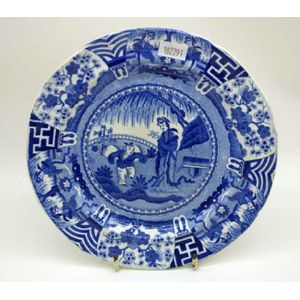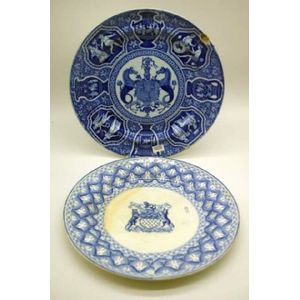Spode Armorial Plates with Mottos and Provenance
You must be a subscriber, and be logged in to view price and dealer details.
Subscribe Now to view actual auction price for this item
When you subscribe, you have the option of setting the currency in which to display prices to $Au, $US, $NZ or Stg.
- A/f, as Inspected - The letters "A/F" or "as inspected" as part of a description is the cataloguer's shorthand for "all faults" or "as found", meaning the item has some type of damage or deficiency, it is of uncertain date or provenance, and/or that the seller takes no responsibility for the completeness of the item or the accuracy of the description.
- Armorial / Armourial - Bearing a coat of arms. Coats of arms came into general use by feudal lords and knights in in the 12th century, and by the 13th century, arms had spread beyond their initial battlefield use to become a flag or emblem for families in the higher social classes of Europe. They were inherited from one generation to the next. When a family crest is used on individual items of silver or furniture it is an indicator of the aristocratic standing of the family represented.
Armorials were also used to decorate mass produced ceramic souvenir ware by such companies as Goss, Carlton & Shelley, and in these cases the coats of arms displayed were of boroughs and cities. - Verso - Verso is the "back" side of a sheet of paper, art work, coin or medal. The front side is "recto".
- Firing Crack - A firing crack is a crack in a porcelain or stoneware item that occurs whilst the item is in the kiln.They are usually caused by faulty design, where one part is thicker than the surrounding area, and being thicker it cools more slowly, setting up a stress with the surrounding area. Firing cracks are not often seen on modern mass produced porcelain, as the damaged items are discarded during prooduction. However they are seen in earlier items and artisan-produced objects.
This item has been included into following indexes:
-
Copeland Spode (England), item types
- plates 181
- plates and platters 224
Visually similar items

Chinese blue and white porcelain plate, decorated with dragons, six character mark within double ring to base, diameter 24 cm

Royal Crown Derby Imari trio and cake plate, plus an extra bread/butter plate, #2451

Spode 'Lange Lijsen' pattern side plate, Impressed mark and printed mark and Butcher collection label to base. Diameter 18 cm

Late 18th century/19th century export ware charger shallow circular, underglaze ink blue painted hunting & panel scenes, 34.5 cm (faults)
